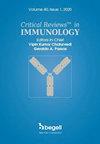Exploring mechanism of Zilongjin in treating lung adenocarcinoma based on network pharmacology combined with experimental verification
IF 0.9
4区 医学
Q4 IMMUNOLOGY
引用次数: 0
Abstract
Objective: Zilongjin (ZLJ) is a common Traditional Chinese medicine for lung adenocarcinoma (LUAD) treatment. However, its mechanisms of action remain to be elucidated. Network pharmacology was used to explore underlying mechanisms of ZLJ on LUAD. Methods: The disease-related targets were found out from the GeneCards and DisGeNET databases. Active compounds and targets of ZLJ were obtained from the HIT, TCMSP, and TCMID databases. Then, the protein-protein interaction (PPI) network was built by STRING database to identify core-hub targets of ZLJ in LUAD. Next, Gene Ontology (GO) and Kyoto Encyclopedia of Genes and Genomes (KEGG) analysis were employed to analyze the enriched regulatory pathways of targets. Molecular docking analysis were used to evaluate interactions between potential targets and active compounds. Finally, qRT-PCR method was further to verify the results of network pharmacology. Results: A total of 124 LUAD-related targets of ZLJ and 5 active compounds of ZLJ from the relevant databases were screened out. Among these target proteins, JUN, CDH1, PPARG, and FOS were core-hub genes in PPI network. GO and KEGG pathway enrichment analysis indicated that these targets might regulate the PPAR signaling pathway in LUAD. JUN, PPARG, and FOS levels were upregulated, while CDH1 level was downregulated in LUAD cells. Conclusion: This study discerned that ZLJ may target genes such as JUN, FOS, PPARG, and CDH1 via the PPAR signaling pathway in LUAD, offering foundational insights for further exploration of ZLJ in clinical applications.基于网络药理学结合实验验证探索紫龙胆治疗肺腺癌的机制
目的:紫龙胆(ZLJ)是治疗肺腺癌(LUAD)的常用中药。然而,其作用机制仍有待阐明。本研究采用网络药理学方法来探讨 ZLJ 对肺腺癌的潜在作用机制:方法:从GeneCards和DisGeNET数据库中找到与疾病相关的靶点。从 HIT、TCMSP 和 TCMID 数据库中获取 ZLJ 的活性化合物和靶点。然后,利用 STRING 数据库构建了蛋白-蛋白相互作用(PPI)网络,以确定 ZLJ 在 LUAD 中的核心-枢纽靶点。接着,利用基因本体论(GO)和京都基因组百科全书(KEGG)分析了靶点的富集调控通路。分子对接分析用于评估潜在靶点与活性化合物之间的相互作用。最后,进一步采用qRT-PCR方法验证了网络药理学的结果:结果:从相关数据库中筛选出了124个ZLJ的LUAD相关靶点和5个ZLJ的活性化合物。在这些靶蛋白中,JUN、CDH1、PPARG和FOS是PPI网络中的核心枢纽基因。GO和KEGG通路富集分析表明,这些靶标可能调控LUAD中的PPAR信号通路。在LUAD细胞中,JUN、PPARG和FOS水平上调,而CDH1水平下调:本研究发现,ZLJ可通过PPAR信号通路靶向LUAD中的JUN、FOS、PPARG和CDH1等基因,为进一步探索ZLJ的临床应用提供了基础性见解。
本文章由计算机程序翻译,如有差异,请以英文原文为准。
求助全文
约1分钟内获得全文
求助全文
来源期刊
CiteScore
2.60
自引率
0.00%
发文量
14
审稿时长
>12 weeks
期刊介绍:
Immunology covers a broad spectrum of investigations at the genes, molecular, cellular, organ and system levels to reveal defense mechanisms against pathogens as well as protection against tumors and autoimmune diseases. The great advances in immunology in recent years make this field one of the most dynamic and rapidly growing in medical sciences. Critical ReviewsTM in Immunology (CRI) seeks to present a balanced overview of contemporary adaptive and innate immune responses related to autoimmunity, tumor, microbe, transplantation, neuroimmunology, immune regulation and immunotherapy from basic to translational aspects in health and disease. The articles that appear in CRI are mostly obtained by invitations to active investigators. But the journal will also consider proposals from the scientific community. Interested investigators should send their inquiries to the editor before submitting a manuscript.

 求助内容:
求助内容: 应助结果提醒方式:
应助结果提醒方式:


